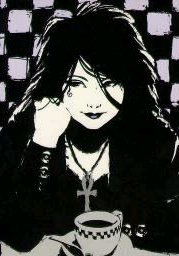Death (DC Comics)
| Death | |
|---|---|

Death, as illustrated by Chris Bachalo. in Death: The Time of Your Life #1.
|
|
| Publication information | |
| Publisher | DC Comics |
| First appearance | (historical) Weird War Tales #1 (October 1971) (modern)The Sandman vol. 2, #8 (August 1989) |
| Created by |
Neil Gaiman (writer) Mike Dringenberg (artist) |
| In-story information | |
| Place of origin | France |
| Team affiliations | The Endless |
| Notable aliases | Grandmother Death (by Nada's tribe) Teleute (Ancient Greek) Madame Mort |
| Abilities | Omnipotence, aspect of death and life, omnipresent, immortality |
Death is a fictional character from the DC comic book series, The Sandman (1989–1996). The character first appeared in The Sandman vol. 2, #8 (August 1989), and was created by Neil Gaiman and Mike Dringenberg.
In the stories, Death is both the end of life and a psychopomp. Like most anthropomorphic personifications of death, Death meets with the recently deceased and guides them into their new existence. However, unlike most personifications of death, she also visits people as they are born, according to Destruction in the Sandman Special: The Song of Orpheus. Evidently, only she seems to remember these encounters. In the special issue, it is also revealed that Death was known in Ancient Greece as Teleute.
Physically, Death is also opposite to the traditional western culture personification of death (see Grim Reaper). In The Sandman, Death instead appears as an attractive, pale young goth woman dressed in casual clothes — often a black top and jeans. She also wears a silver ankh on a chain around her neck, and has a marking similar to the eye of Horus around her right eye. She is pleasant, down-to-earth, perky, and has been a nurturing figure for both incarnations of Dream. This irony has helped make Death one of the most popular characters from Sandman. Death was named the fifteenth greatest comic book character by Empire Magazine.
Other personifications of Death have appeared in the DC Universe. These altering physical appearances may be rationalized as being completely different characters with an unknown relation (or lack thereof) to the overall Death shown in the Sandman series, or may be explained by a sequence at the beginning of the Sandman series. In the sequence where Morpheus is searching for his objects of power, he appears at Martian Manhunter's door, and for a frame we see him as Martian Manhunter sees him: it's nothing like humans see him. This could indicate that the physical appearance of the Endless (the appearance of Dream, at the very least) is subject to the mind of the person doing the observing. Many references are made throughout Death and the Sandman series which indicate that perception of the form of the Endless is subjective, not objective.
...
Wikipedia
